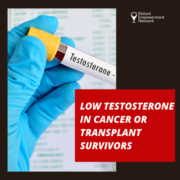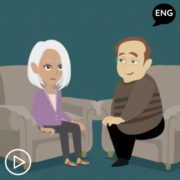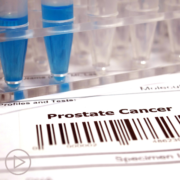Low Testosterone in Cancer or Transplant Survivors
I was one of the authors (out of more than 50) of a review article on male specific late effects in stem cell transplant patients [1]. The article looked at many late effects in male transplant survivor. This post is a summary on one late effect, hypogonadism (that is low testosterone) as well as my opinion about the recommendations on screening for low testosterone.
We do not know much about low testosterone in cancer survivors or transplant survivors. There is a significant increase in the incidence of low testosterone but the size of the increase in transplant survivors is not well understood. Symptoms related to low testosterone include: “loss of body hair, small testes, and ED (Erectile Dysfunction)”. Other symptoms that may be signs of low testosterone but may be signs of other problems include: “loss of libido, anemia, fatigue, lack of motivation, reduced muscle mass, and increased fat mass” (I don’t really know what “lack of motivation” means). The article recommends: “testing and consideration of hormone replacement therapy based on symptoms”. This is similar to what has been recommended in the past [2].
In 2016, some 23 years after my bone marrow transplant (BMT) I was diagnosed with low testosterone. I had finally asked one of my doctors to get tested and my testosterone level was 192 (my free testosterone was also low, and this is useful for the doctors, but I won’t mention it anymore). The normal level of testosterone is between 300 and 1000 nanograms per deciliter (ng/dL). [3] While I had symptoms, low libido, loss of muscle mass and fatigue primarily, no doctor had asked about those symptoms, and I had not thought about them as more than getting old.
I started on testosterone replacement, and it has made a huge difference. The biggest difference in my mind is less fatigue. One of the more common side effects of testosterone replacement is it can raise your red blood count (I like to call this an “effect”). Since a year or two after my transplant, my hemoglobin was on the low side (typically 12-13, normal for men is 13.2-16.6) and my hematocrit was generally between 37 and 40% (normal for men is 38.3-48.6%) [4]. A few years ago, at my annual exam my hematocrit was close to 35%. I went to see an oncologist (the oncologist who treated me is no longer seeing patients in the office). A whole bunch of tests were run, but not a testosterone test and nothing abnormal other than my red blood values was found. After starting testosterone replacement, my hematocrit is 43-45% and my hemoglobin is 14-15. The biggest change for me is that I have far less fatigue presumably because I have more red blood cells.
Testosterone levels naturally decrease with age. The folklore is that the testosterone level decreases about 1% per year from age 30 or so. [5] Other sources say from age 20. I believe this means that if you level is 800 at age 30 (there seems to be little data for a “normal” level at different ages), it will go down about 8 units per year (1% of 800). So, at age 80, the level would be around 400 (if this actually means a decrease of 1% of the current level every year, it will go down to about 480 at age 80). If the level was 600 at age 30, then it would be about 300 at age 80 (or around the low end of the normal range, which I imagine is about the average level for 80-year-old men). What if a 30-year-old had a testosterone level of 800 and then was diagnosed with AML and had chemotherapy and a transplant? Perhaps 2 years post-transplant is now 500, which is normal. There seems to be no data on testosterone levels in long term transplant survivors. However, if this goes down 8 units a year (this seems to be as good a guess as any), then after 25 years the level would be 320 and after 30 years it would 280, which is less than the 80-year-old man without cancer. It is important to state that there appears is no data to support or refute this scenario. Still my belief is that this is essentially what happened to me. My guess is that quite a few male transplant survivors have a testosterone level in the normal range 1 or 2 years post-transplant (although most will not have it tested) but will eventually have hypogonadism and likely not realize it.
While there is a lot we do not know about testosterone levels in transplant survivors (or for that matter healthy men), there is one thing we do know. “The majority of health care professionals do not address [sexual dysfunction]” [1]. In my mind this calls into question the recommendation to test testosterone levels “based on symptoms”. Most doctors do not seem to ask about symptoms specific to low testosterone and the other symptoms are non-specific. It seems to me that not testing testosterone levels at say 1 or 2 years post-transplant is likely causing harm to some male long term survivors. A better guideline would be to routinely test 1 or 2 years post-transplant and then again if symptoms warrant.
The BMT Infonet as part of their Celebrating a Second Chance at Life Symposium had a really good workshop on Sexual Concerns in Men after Transplantation by John Mulhall MD, from Memorial Sloan Kettering Cancer Center. You will have to register before viewing the replay of this workshop. While it covered other topics, there was a lot of information about low testosterone
Contact Art Flatau, flataua@acm.org
Bibliography
[1] Phelan, R et. al., “Male-Specific Late Effects in Adult Hematopoietic Cell Transplantation Recipients: A Systematic Review from the Late Effects and Quality of Life Working Committee of the Center for International Blood and Marrow Transplant Research and Transplant Complica,” Transplantation and Cellular Therapy, 2021.
[2] Navneet, Majhail S.; et. al., “Recommended Screening and Preventive Practices for Long-Term Survivors after Hematopoietic Cell Transplantation,” Biology of Blood and Marrow Transplantation, vol. 18, no. 3, pp. 348 – 371, 2012.
[3] Icahn School of Medicine at Mount Sinai, “Testosterone,” [Online]. Available: https://www.mountsinai.org/health-library/tests/testosterone
[4] Mayo Clinic, “Complete Blood Count,” [Online]. Available: https://www.mayoclinic.org/tests-procedures/complete-blood-count/about/pac-20384919
[5] Mayo Clinic, “Testosterone therapy: Potential benefits and risks as you age,” [Online]. Available: https://www.mayoclinic.org/healthy-lifestyle/sexual-health/in-depth/testosterone-therapy/art-20045728
[6] WebMd, “Is Testosterone Replacement Therapy Right for You?,” [Online]. Available: https://www.webmd.com/men/guide/testosterone-replacement-therapy-is-it-right-for-you

AML Network Manager
Art Flatau lives in Austin, Texas with his wife Gretchen. They have 2 grown children. He was diagnosed with Acute Myeloid Leukemia (AML) in 1992 at the age of 31, while still in graduate school at the University of Texas. Gretchen and Art’s kids were 2 and 4 at the time. He received chemotherapy (both induction chemotherapy and then consolidation). After graduating with a Ph.D. in computer science in December 1992. He relapsed in early 1993 and then had a bone marrow transplant (BMT), his brother was a perfect match.











Thanks for helping me understand that aging can naturally lower a person’s testosterone levels which happens around 1% a year once you reach your 30s. I guess getting ourselves checked regarding this matter immediately see if we already need testosterone therapy. And I think it is important to get treatments as soon as possible whatever conditions a person would have to prevent them from getting worse.